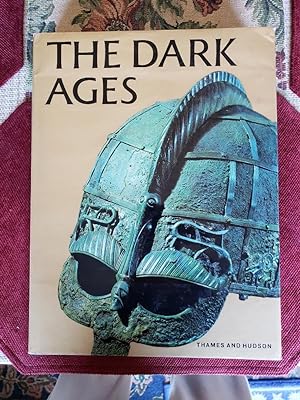About this Item
large dark blue & gilt decorative cloth hardbound folio ~ 2º (11"x14"). very large & heavy ("coffee table" book), international or priority shipping will cost extra. dustwrapper in protective plastic book jacket cover. fine cond. binding square & tight. covers clean. edges clean. contents free of markings. dustwrapper in fine cond. couple of tiny nicks, not torn or price clipped. nice clean copy. no library markings or store stamps, no stickers or bookplates, no names, no inking , no underlining, no remainder markings etc ~. third printing. ~ 360p. 200 pictures in full color. 475 monochrome photographs, line drawings, plans, maps and charts. chronological chart. select bibliography. list and sources of illustrations. index. medieval history. art history. archeology. medieval literature. folklore. mythology. history of europe. ~ IN AD 400 the Roman Empire was intact and all~powerful; six hundred years later new peoples, new cultures were everywhere established, and the various national boundaries were substantially those of Europe today. Western civilization had passed through the most serious crisis of which we have historical record. Yet it is far less familiar, even to the educated public, than either the age of Greece and Rome which preceded it or the Middle Ages which came after. No full~scale illustrated survey has ever been attempted. Why the 'Dark Ages'? Dark the period must certainly have been to many of those who lived through it, and until recently dark also to the historian. But modern research and re~interpretation, especially in archaeology, have pieced together the whole complex story with a vividness and authenticity which had previously appeared impossible. The haunting apt of an age in turmoil ~ The book is divided into four main sections. The first gives the background of events in the East Mediterranean area, where the flowing tide of Islam was washing against the frontiers of the West. The second deals with Byzantium ~ a rich and glorious state whose traditions, wealth and art were of paramount importance. The third describes the migrating tribes from the north and east who were reshaping Europe ~ the Slavs, Ostrogoths, Visigoths, Lombards, Franks, Norsemen, Angles and Saxons. The distinctive character of these peoples is vividly expressed in their brilliant, sometimes bizarre, art, much of which is here presented in colour for the first time. The last section shows the threads being gathered together in the hands of Charlemagne and his successors and the achievement of a new stability based firmly on feudalism and Christianity. Each of the fifteen chapters is written by an acknowledged authority. It is a book which no one man could have written. And as in the other volumes of this series, the illustrations are unsurpassed in range, interest and quality. Besides the well~known masterpieces of Byzantine and Carolingian art, many less familiar works are included. Careful reconstructions have been specially commissioned (on large fold~out pages), and there are numerous maps, plans and family trees. The editor is Professor David Talbot Rice, a famous scholar whose gifts as a writer and lecturer have won him a popularity far beyond the academic world. This volume, the result of three years' preparation, now brilliantly illuminates a vital phase in the history of mankind. 'This magnificent volume . Superb plates and excellent line drawings . . . the whole ground is well covered', SIR STEVEN RUNCIMAN, in the Sunday Times. 'There is endless interest here', ANTHONY POWELL, in the Daily Telegraph.
Seller Inventory # 10281902
Contact seller
Report this item



